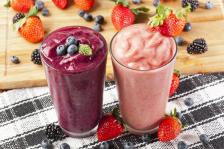How to Make the Perfect Smoothie
Don’t let the wrong ingredients turn your healthy smoothie into a sugar-loaded calorie-bomb. Check out Nutrition Diva’s video for creating a delicious, nutritious smoothie
Smoothies are super popular with the healthy eating crowd and with the right ingredients, smoothies can make a nutritious breakfast, snack, or post-workout meal. But if you’re not careful, a smoothie can easily turn into a sugar-loaded calorie bomb. Here’s how to make a smoothie that’s both good and good for you.
Perfect Smoothie Step #1: The Base
First, you need some sort of liquid or semi-liquid base. You can use milk or a non-dairy alternative such as soymilk—but if you use soy or another non-dairy milk, be aware that even the plain, unsweetened ones can have a lot of added sugar. As I suggested in my article on non-dairy milk, try to find a brand that has no more than 12g of sugar per eight-ounce serving.
What’s the Best Base for a Smoothie?
Even better, use plain yogurt as the base of your smoothie. Yogurt contains beneficial bacteria which, as I explained in my article on frozen yogurt, are not at all harmed by being blended up with ice or frozen fruit.
I don’t recommend using fruit juice as the base for your smoothie, however, because it is so high in sugar. That’s my biggest gripe with smoothies from Jamba Juice and other juice bar chains, by the way. They’re usually made with a lot of fruit juice and, as a result, are very high in sugar and calories.
Put about one cup of base into the jar of your blender.
Perfect Smoothie Step #2: Add Fruit
Fruit adds sweetness to your smoothie but also fiber and other nutrients. If you use frozen fruit, it will also make your smoothie thick and frosty, sort of like a milkshake. Frozen bananas are great for this because they contain pectin, a sort of fiber that makes the smoothie extra creamy-tasting. Whenever you have bananas that are getting a little too ripe, toss them in the freezer to use for smoothies.
Quick and Dirty Tip: Peel your bananas BEFORE freezing them. They are impossible to peel once they’re frozen!
Which Fruit Should You Add to a Smoothie?
Frozen strawberries are also terrific in smoothies, as are peaches and mangoes. Blueberries and raspberries, although they are quite nutritious, tend to be a little gritty in smoothies.
Add about one serving of fruit to the blender. If you prefer to use fresh, unfrozen fruit, add a couple of ice cubes as well.
Perfect Smoothie Step #3: Add Protein
A cup of milk, soymilk, or yogurt contains about ten grams of protein. (Other non-dairy milks contain much less). To make the smoothie a bit more substantial, add some extra protein. Some people like to use protein powders for this but, as you know, I like to get my nutrition from foods rather than supplements whenever possible. You can boost the protein content of your smoothie by adding a chunk of tofu or a couple of tablespoons of peanut butter or other nut butter. Peanut butter goes particularly well in smoothies that contain bananas.
I don’t recommend adding raw egg to your smoothie, Rocky-style. Not only is there a slight danger of salmonella poisoning with uncooked eggs, but your body absorbs the protein in eggs much better when they’re cooked.
Optional Extras
You can dress up your smoothie with all kinds of extras:
Flax- Add 2 tablespoons of flax, chia, or hemp seed to add some extra fiber, protein, and a nice helping of omega-3 fatty acids.
Quick and Dirty Tip: Flax seed contains a lot of soluble fiber, which tends to absorb liquid and form a gel. That’s great when it happens in your body; not so great when it happens in your glass. If you’re not going to be drinking your smoothie within twenty minutes or so, you might want to leave the flax out.
Cocoa Powder Cocoa powder is jam packed with flavanols—the compounds that make chocolate so good for you. But unlike chocolate, it’s low in calories, contains no sugar, and is virtually fat-free. Add a tablespoon of cocoa powder for a heart-healthy boost. Cocoa powder tastes good in smoothies made with bananas and/or nut butter.
Quick and Dirty Tip: If it’s the health benefits of cocoa you’re after, avoid “dutched” or alkalized cocoa powder, which has less than half the flavanol content of regular cocoa powder.
Greens- A lot of people like to throw in a handful of raw spinach or other leafy greens. Although it turns your smoothie a bright, virtuous-looking green color, you can’t really taste them and it’s a great way to sneak another serving of vegetables into your day. Greens go well with strawberry or peach flavored smoothies.
Quick and Dirty Tip: Greens, especially spinach, contain oxalates, which are compounds that can interfere with your ability to absorb calcium. If the milk or yogurt in your smoothie is your primary source of calcium, you might want to save the greens and have them at a different meal.
Perfect Smoothie Step #4: Blend
Whiz everything in the blender on high until it’s completely blended. If your smoothie is too thick, you may be using too much frozen fruit or too many ice cubes. Thin it by adding a bit of water or even a splash of green tea or coffee. Coffee goes particularly well in smoothies made with banana, nut butter, and/or cocoa powder. Green tea is a great match for a strawberry or peaches. Both tea and coffee add beneficial antioxidants, not to mention caffeine, which has its own benefits. (You can even use coffee or green tea as part of the liquid in step one.)
If your smoothie isn’t sweet enough for your taste, you can add a bit of honey or maple syrup, but keep in mind that even natural sweeteners like honey and maple syrup count as added sugars and should be kept to a minimum. You could also use a sugar-free sweetener like stevia.
Are Smoothies Healthy?
Finally, just because it’s packed with nutrition and—for goodness sake!—spinach, doesn’t mean that the calories in that smoothie don’t count. Make sure that you have a realistic grip on how many calories your smoothie contains so that you know how it fits into your overall diet plan. Here’s a chart of common smoothie ingredients that you can use to see how your favorite smoothie adds up.
Nutrition Diva’s Smoothie Calculator
| Country | |||
|---|---|---|---|
|
Ingredient |
Protein (g) |
Fiber (g) |
Calories |
|
1 cup 2% milk |
8 |
0 |
122 |
|
1 cup soymilk |
9 |
2 |
110 |
|
1 cup lowfat yogurt |
13 |
0 |
154 |
|
1 medium banana |
1 |
3 |
105 |
|
¾ cup frozen strawberries |
1 |
2 |
38 |
|
¾ cup frozen peaches |
1 |
2 |
60 |
|
2 ounces tofu |
5 |
1 |
48 |
|
2 tablespoons peanut butter |
7 |
2 |
180 |
|
2 tablespoons flaxseed |
4 |
6 |
110 |
|
1 tablespoon cocoa powder |
1 |
2 |
12 |
|
1 cup spinach |
1 |
1 |
7 |
|
1 teaspoon honey |
0 |
0 |
20 |
|
1 teaspoon maple syrup |
0 |
0 |
13 |
Look up nutrition facts for other ingredients on NutritionData.com
Keep in Touch
If you have a suggestion for a future show topic or would like to find out about having me speak at your conference or event, send an email to nutrition@quickanddirtytips.comcreate new email.
You can also post comments and questions—or your favorite smoothie recipes—on my Nutrition Diva Facebook Page. I answer a lot of listener questions in my free weekly newsletter, so if you’ve sent a question my way, be sure you’re signed up to receive that.



